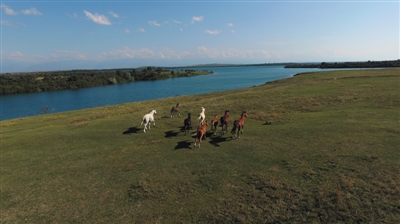This part of the Silk Road, actively functioning throughout all Middle Ages, is known as "Hsuan-Tsang's road", the pilgrim, who passed it in 629 AD. The Chinese records describe this branch from east to west, Arabic and Persian - from west to east. Traditionally, it is considered that it went through Bedel, Seok passes, Ara Bel valley, Sary-Moinok, Barskoon passes, through Barskoon valley and to the southern coast of the lake, then along the southwestern coast went to the West and through Boom gorge passed to the Chui valley. This part of the route is traced by a range of sites and settlements, which are identified with historical cities of the area of Upper Barshan. Site of Barskoon 2 is located in the heart of gorge, on the right terrace above the floodplain. It has square form with sides 60 x 60m, oriented to cardinal points. Semicircular towers were traced in the corners and in the centre of southern, western and northern walls; entrance was in the centre of the eastern wall. The site functioned as a fortress protecting entrance and exit from gorge and accordingly, the part of the route going through Barskoon and Bedel passes to the area of Aksuu. Excavations are carried out in the middle of 20th century; the settlement is dated from the early Middle Ages till XII centuries AD. To the west of this site, in the natural boundary of Tamga, in 2 km to the south of the settlement Tamga, there are three stones with the Tibetan inscriptions containing the formula "Ohm mani padme hum"; dated back to Jungar times, XV-XVIII centuries AD. Burial ground of Turkic time (funeral and burial sites with stone sculptures) is located on a floodplain terrace. According to some researchers, places with Buddhist epigraphics, mark use of Silk Road caravan routes, known from the early and late Middle Ages, by pilgrims to Tibet. Now, the local Kyrgyz population considers this site as a mazar - a sacred place. On the coast, there is the Tosor site on the route, which served as a fortress between two large cities of the area: Barshan and Ton (Тun, Dun). It is on the western end of Tosor village, in 200 m to the north from Balykchi-Karakol road. It has square form with sides 100х100m, oriented to cardinal points. Semicircular towers were traced in the corners and on the walls. L-shaped entrance is located in the centre of the eastern wall and, the eastern side of the entrance is strengthened by a tower. The topography of the site and materials of excavation of 1960s made a basis for its dating as Karahanid time. City of Dun is identified with Khan-Dobo or Ton settlement, located on the left floodplain terrace of the river Ton, in the entrance to the gorge. It consists of the central ruins and the territory surrounded with two long walls. The citadel has the form of the truncated cone with sides in the basis of 60х60m, with the height of more than 10 m. A platform, limited with low walls, which served as a court yard for the citadel adjoins its northern side. The surrounding area has traces of numerous constructions in the form of mounds of various forms and stone basements of constructions. The Central part is surrounded by a wall with numerous towers in distance of 40-50 m from each other, 12-15 m projecting from the side of the wall, height of the wall is 3-5 m, width in the basis is 10-12 m. Western and northern walls are well traced where entrances to the city are located. The greatest length of the central part of the site makes 600 m, width is 500 m. Functioning of the central part is dated back from VII to XII centuries AD, the second part of the site adjoins the main site from the south, the east and the north, is surrounded by a ring of walls with towers. Height of the wall is 2-3 m; width in the basis is 10-15 m. Traces of constructions and cultural layers are detected inside the walls. River Tuura-Suu flows through the territory of this part of the site. Adjoining third part of the site is also surrounded with a ring of wall, constructed on the edge of a floodplain terraces of the river Ton. Small settlements are detected in the vicinity of the site; there are some settlements deeper in a gorge, in the direction to Ton pass, which was on the way connecting Issyk-Kul with Tien Shan and Fergana. Remains of the defensive wall indicating western border of the territory of the Upper Barshan in X-XII centuries AD is another site of the time of intensive functioning of the Silk Road in this area. It is located on the left bank of the river Ton, to the south from Balykchi-Karakol road, in the cemetery. From Ton to the West the road went along the lake coast, through a number of settlements, some of them have occupation layers of the early Middle Ages, but mainly they functioned in Karahanid period. Transit to Chui valley was made through Boom gorge. Sites-components of these series are in the State Lists of monuments of national and local importance. These monuments and settlements are in a zone of active economic development and are affected by development factors. The present state of sites demonstrates their topography, constructive features and thickness of the occupation layer. The material collection is stored at the State Historical Museum in Bishkek. Local administrations are in charge of the legal and physical protection at the local level, the Agency for Culture on national level.  |
 |Archiver|小黑屋|丝路遗产丝绸之路:长安天山廊道的路网
( 陕ICP备07011065号-3 )
|Archiver|小黑屋|丝路遗产丝绸之路:长安天山廊道的路网
( 陕ICP备07011065号-3 )
GMT+8, 2024-4-20 02:00 , Processed in 0.065667 second(s), 19 queries .
Powered by Discuz! X3.5
© 2001-2024 Discuz! Team.